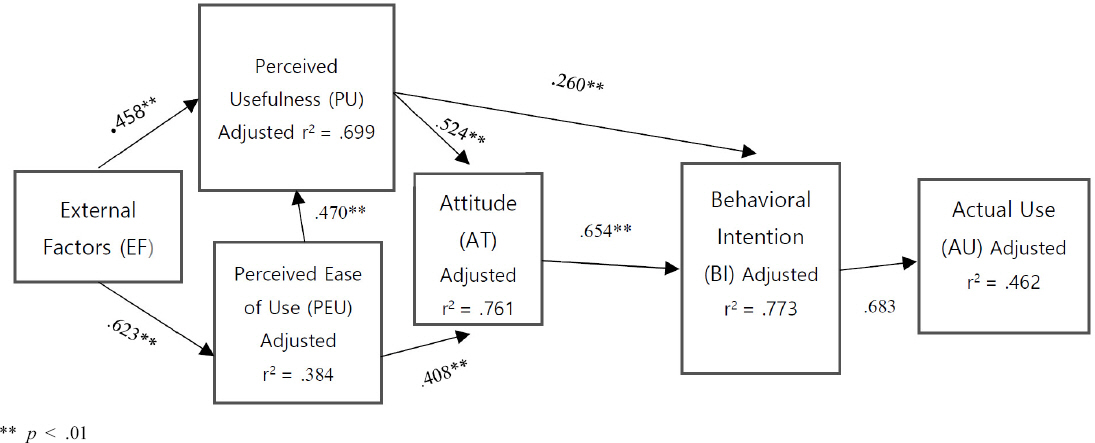Baber, H(2021 Modeling the acceptance of e-learning during the pandemic of COVID-19:A study of South Korea,
The International Journal of Management Education 19(2), 100503.https://doi.org/10.1016/j.ijme.2021.100503.


Beavers, A. S, Lounsbury, J. W, Richards, J. K, Huck, S. W, Skolits, G. J, Esquivel, S. L(2013). Practical considerations for using exploratory factor analysis in educational research, Practical Assessment, Research &Evaluation 18(6), 1-13.
Briggs, N(2018 Neural machine translation tools in the language learning classroom:Students'use, perceptions, and analyses,
The JALT CALL Journal 14(1), 3-24. https://doi.org/10.29140/jaltcall.v14n1.221.

Cha, K.Y, Kwon, S. J(2018). Understanding the adoption of e-learning in South Korea:Using the extended Technology Acceptance Model approach, KEDI Journal of Educational Policy 15(2), 163-183.
Copeland, C, Franzese, J(2021 Using the technology acceptance model to understand attitudes about a virtual learning environment for EFL writing,
Korean Journal of General Education 15(5), 215-227. https://doi.org/10.46392/kjge.2021.15.5.215.


Davis, F. D(1989 Perceived usefulness, perceived ease of use, and user acceptance of information technology,
Management Information Systems Quarterly 13(3), 319-340. https://doi.org/10.2307/249008.

Dziuban, C. D, Shirkey, E.C(1974). When is a correlation matrix appropriate for factor analysis?Some decision rules,
Psychological Bulletin 81(6), 358-361.

Hair, J. F(2003). Essentials of business research methods,
John Wiley &Sons Incorporated.

Im, H. J(2017). The university students'perceptions or attitudes on the use of the English automatic translation in a general English class - Based on English writing lessons, Korean J General Edu. 11(6), 727-751.
Inozu, J, Sahinkarakas, S, Yumru, H(2010). The nature of language learning experiences beyond the classroom and its learning outcomes, 美中外语 1:14-21.
Jeon, J, Lee, S(2023 Large language models in education:A focus on the complementary relationship between human teachers and ChatGPT,
Education and Information Technologies 28:15873-15892. https://doi.org/10.1007/s10639-023-11834-1.


Jones, S, Richards, A, Cho, Y, Lee, Y. J(2019). Pedagogical ramifications of fourth industrial revolution technology on general English classes from Korean students perspective, Korean Journal of General Education 13(4), 501-532.
Kim, G, Lee, S(2016 Korean students'intentions to use mobile-assisted language learning:Applying the technology acceptance model,
International Journal of Contents 12(3), 47-53. https://doi.org/10.5392/ijoc.2016.12.3.047.

Kim, N.-Y(2016). Effects of voice chat on EFL learners'speaking ability according to proficiency levels, Multimedia-Assisted Language Learning 19(4), 63-88.
Kim, N. Y, Cha, Y, Kim, H. S(2019). Future English learning:Chatbots and artificial intelligence, Multimedia-Assisted Language Learning 22(3), 32-53.
Kim, S, Shim, J, Shim, J(2023 A study on the utilization of OpenAI ChatGPT as a second language learning tool,
Journal of Multimedia Information Systems 10(1), 79-88. https://doi.org/10.33851/JMIS.2023.10.1.79.


Lee, J. S, Kiaer, J, Jeong, S(2023 The role of informal digital learning of Korean in KFL students'willingness to communicate,
Journal of Multilingual and Multicultural Development DOI:10.1080/01434632.2023.2216671.

Liu, G, Ma, C(2023 Measuring EFL learners'use of ChatGPT in informal digital learning of English based on the technology acceptance model,
Innovation in Language Learning and Teaching 1-14. https://doi.org/10.1080/17501229.2023.2240316.

Marikyan, D, Papagiannidis, S. (2022 Technology acceptance model:A review,
TheoryHub Book,
http://open. ncl.ac.uk
McLoughlin, C, Lee, M. J. W(2010 Personalized and self-regulated learning in the Web 2.0 era:International exemplars of innovative pedagogy using social software, Australasian Journal of Educational Technology 26(1), https://doi.org/10.14742/ajet.1100.
Pan, X(2020 Technology acceptance, technological self-efficacy, and attitude toward technology-based self-directed learning:Learning motivation as a mediator,
Frontiers in Psychology 11:https://doi.org/10.3389/fpsyg.2020.564294.

Park, S. Y, Nam, M.-W, Cha, S.-B(2011 University students'behavioral intention to use mobile learning:Evaluating the technology acceptance model,
British Journal of Educational Technology 43(4), 592-605. https://doi.org/10.1111/j.1467-8535.2011.01229.x.

Shaengchart, Y(2023). A conceptual review of TAM and ChatGPT usage intentions among higher education students, Advance Knowledge for Executives 2(3), 1-7.
Shaikh, S, Yayilgan, S.Y, Klimova, B, Pikhart, M(2023 Assessing the usability of ChatGPT for formal English language learning,
European Journal of Investigation in Health, Psychology and Education 13(9), 1937-1960. https://doi.org/10.3390/ejihpe13090140.



Stevens, J. P(2009 Applied multivariate statistics for the Social sciences,
Routledge 5th ed. https://doi.org/10.4324/9780203843130.

Venkatesh, V, Davis, F. D(2000 A theoretical extension of the technology acceptance model:four longitudinal field studies,
Management Science 46(2), 186-204. https://doi.org/10.1287/mnsc.46.2.186.11926.

Xiao, Y, Zhi, Y(2023 An exploratory study of EFL learners'use of ChatGPT for language learning tasks:Experience and perceptions,
Languages 8(3), 2-12. https://doi.org/10.3390/languages8030212.











